Imagine inspiring a lifelong love of learning in your child. Engaging your preschooler in fun, educational stem activities can do just that. Simple stem activities help your child develop important skills and curiosity. By trying preschooler stem experiments at home, learning becomes a fun, enjoyable journey.
As a parent, you play a big role in your child’s education. By adding stem activities for preschoolers to your daily routine, you support their growth in science, technology, engineering, and math. These activities can be tailored to your child’s interests and abilities, making learning exciting and effective.
Key Takeaways
- Engage your preschooler in fun and educational stem activities for preschoolers to inspire a love of learning
- Try easy stem activities at home to help your child develop essential skills
- Preschooler stem experiments can help your child develop a curiosity about the world around them
- Incorporating stem activities for preschoolers into your daily routine can help your child develop a strong foundation in science, technology, engineering, and math
- Easy stem activities can be adapted to fit your child’s interests and abilities
- By trying out preschooler stem experiments, you can set your child up for success and make learning a fun, enjoyable experience
Understanding STEM Education for Preschoolers
As a parent, you want the best for your child. Starting them early with STEM education is a great idea. It’s all about sparking curiosity and learning through fun activities. This way, your child can develop important skills for the future.
Studies show that STEM education at a young age boosts learning and success later on. It helps kids think critically, solve problems, and be creative. Simple experiments, like making a volcano or a lava lamp, can make learning fun and engaging.
- Encouraging curiosity and asking open-ended questions
- Providing opportunities for hands-on experimentation and exploration
- Using everyday objects to demonstrate scientific concepts
By following these tips, you can help your child love learning. This sets them up for success in the years to come.
Safety First: Creating a STEM-Friendly Environment at Home
When you start stem projects at home, safety is key. To make a good space for fun stem activities, you need a safe and easy area. Cover your work surface with a plastic tablecloth or newspaper. Wear goggles and gloves. Make sure all materials are within reach.
To get started, consider these tips:
- Choose a specific area for STEM activities to avoid clutter and distractions.
- Store materials in labeled containers to keep them organized and easy to find.
- Set rules for clean-up and disposal of materials to keep the environment safe and healthy.
By following these guidelines, you can make a STEM-friendly home environment. This environment will encourage fun stem activities and stem projects at home safely.
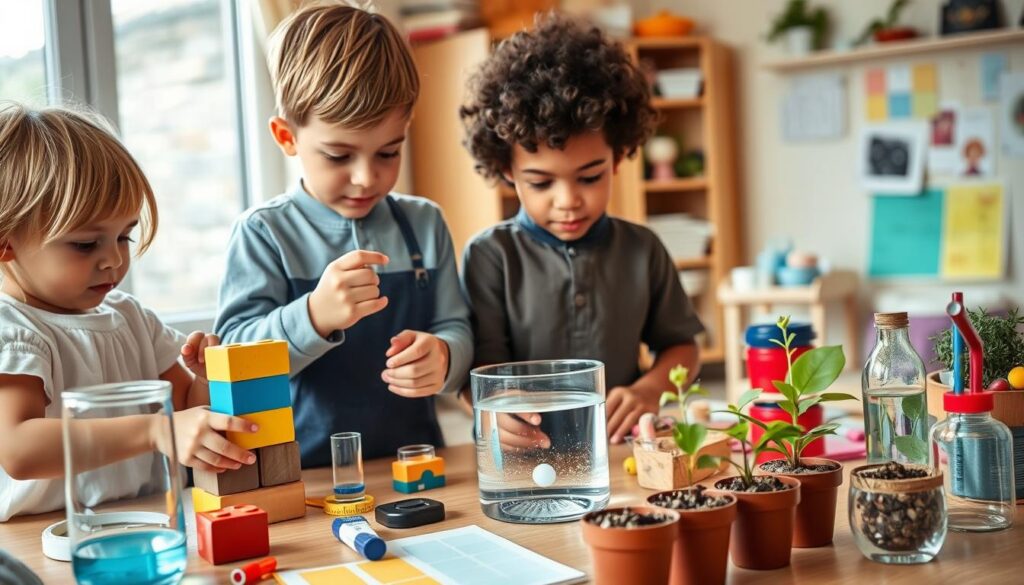
Remember, safety is vital in STEM activities. By taking the right precautions and creating a safe space, you help your child love stem projects at home and fun stem activities for life.
| STEM Activity | Safety Precaution |
|---|---|
| Chemical Experiments | Wear protective gloves and goggles |
| Electrical Projects | Use insulated wires and avoid overloading circuits |
| Building and Construction | Use safety glasses and a dust mask when working with power tools |
Essential Materials for Preschool STEM Activities
To start easy stem activities and educational stem play, you need basic materials. These are often found at home, making it easy to begin. Items like paper, glue, scissors, and cardboard tubes are great for STEM experiments.
Choosing the right materials is key for easy stem activities. Everyday objects can turn into fun learning tools. For instance, a plastic bottle can become a homemade lava lamp. Or, you can make a marble run with cardboard and tape.
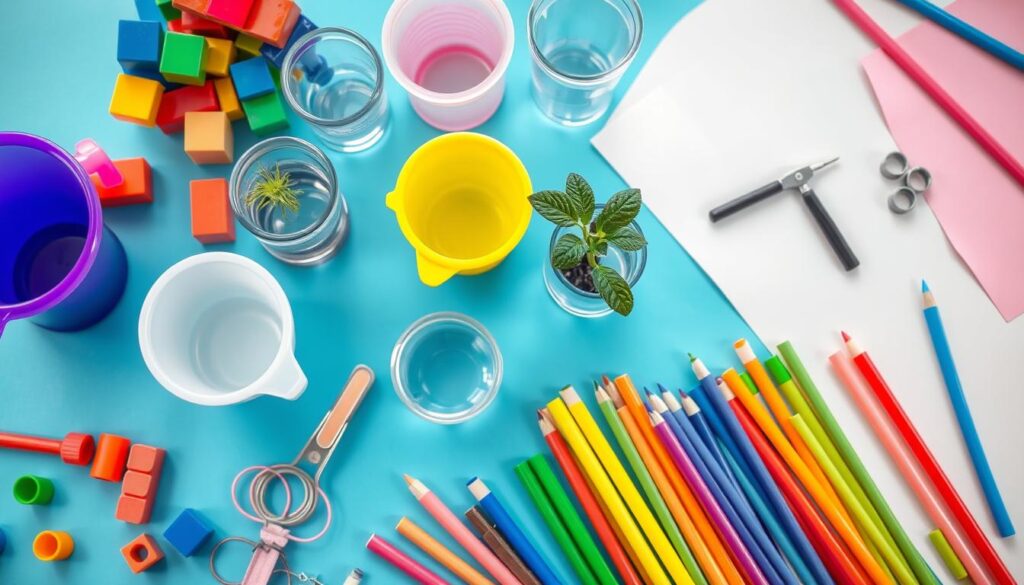
For more advanced projects, you might want specialized materials. These include magnets, batteries, and LED lights. With these, you can create complex projects like simple circuits or robots.
Common Household Items You’ll Need
- Paper
- Glue
- Scissors
- Cardboard tubes
Optional Specialized Materials
- Magnets
- Batteries
- LED lights
Keep your materials in a safe spot. This makes it easy to do easy stem activities and educational stem play whenever you like.
STEM Activities for Preschoolers: Easy Experiments to Try at Home
Getting your child into stem activities for preschoolers can spark their curiosity and love for learning. Simple science experiments are a great way to introduce them to science, technology, engineering, and math. These experiments can be adjusted for different ages and skill levels, making them perfect for preschoolers.
Some examples of simple science experiments for preschoolers include:
- Making a volcano using baking soda and vinegar
- Creating a homemade lava lamp using oil, water, and food coloring
- Building a bridge using popsicle sticks and clay
These experiments are not only fun but also educational. They teach your child about chemical reactions, density, and engineering. By trying these stem activities for preschoolers, your child can improve their problem-solving skills, hand-eye coordination, and critical thinking.
Always supervise your child during these experiments. Encourage them to ask questions and think critically. With a little creativity and imagination, you can turn your home into a stem laboratory. This provides your child with a fun and engaging learning experience.
| Experiment | Materials Needed | Age Group |
|---|---|---|
| Making a Volcano | Baking soda, vinegar, clay | 3-5 years |
| Homemade Lava Lamp | Oil, water, food coloring, Alka-Seltzer tablets | 4-6 years |
Simple Science Experiments with Water
Doing hands-on stem for kids activities is a great way to spark curiosity and love for learning. Water-based experiments are perfect for this, with fun stem activities that are both fun and educational. Start by filling a container with water and adding different objects to see which ones float or sink. This introduces your child to the concept of density.
For a colorful twist, try color mixing adventures by adding food coloring to water. This simple experiment can lead to cool discoveries about primary and secondary colors. Another fun activity is exploring ice and state changes, where you can see how water changes from solid to liquid and then to gas.
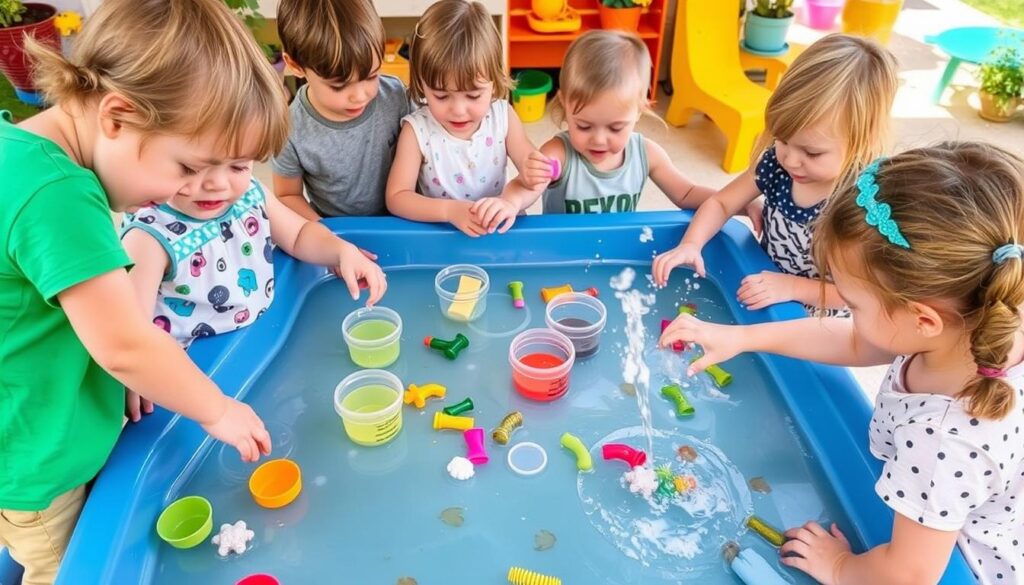
- Creating a homemade lava lamp using oil, water, and food coloring
- Building a bridge with everyday materials to test its strength over water
- Exploring the concept of buoyancy by designing a boat that can hold a certain amount of weight
These experiments are not just fun but also provide valuable learning experiences. They help your child develop essential skills in science, technology, engineering, and mathematics. By doing hands-on stem for kids activities, you can inspire a lifelong love of learning and exploration in your child.
| Experiment | Materials Needed | Learning Outcome |
|---|---|---|
| Floating and Sinking | Container, water, various objects | Understanding density and buoyancy |
| Color Mixing | Water, food coloring | Introduction to primary and secondary colors |
| Ice and State Changes | Ice, water, thermometer | Observing changes in state from solid to liquid to gas |
Building and Engineering Projects
Doing stem projects at home is a fun way to help your child learn and grow. It boosts their fine motor skills and creativity. You can use simple materials like blocks, LEGO, or cardboard boxes to start.
Some examples of stem projects at home include:
- Building a bridge with popsicle sticks and glue
- Creating a marble run using cardboard tubes and tape
- Designing a simple machine using LEGO pieces
These projects let your child learn by doing. They help improve problem-solving and critical thinking. By making stem projects a part of your child’s daily life, you make learning fun and engaging.
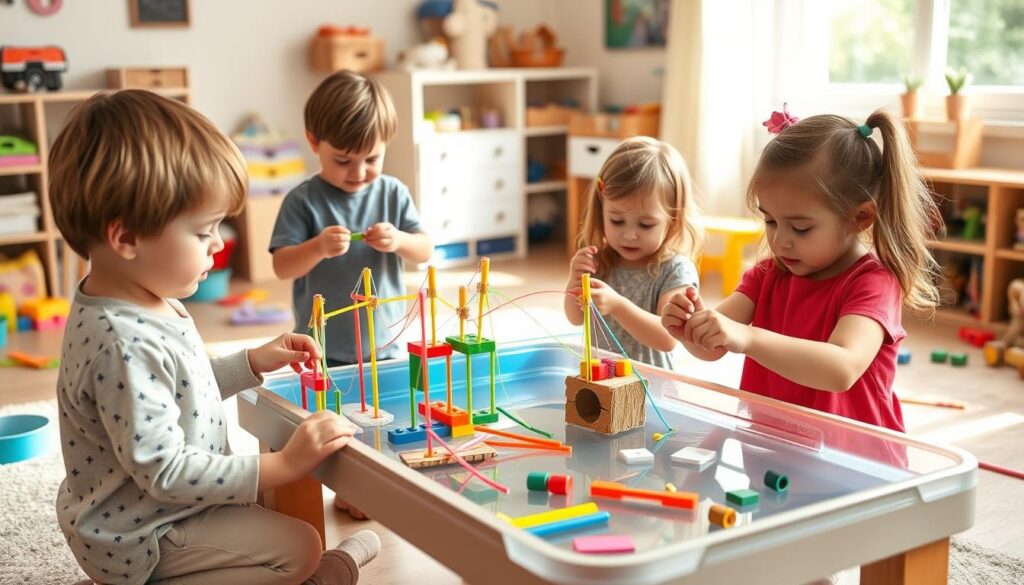
As your child gets better at building and engineering, you can try more challenging projects. These projects will help them think creatively and solve problems. With a bit of imagination, the world of stem projects at home is full of possibilities for fun and learning.
| Project | Materials | Skills Developed |
|---|---|---|
| Building a bridge | Popsicle sticks, glue | Problem-solving, critical thinking |
| Creating a marble run | Cardboard tubes, tape | Fine motor skills, creativity |
| Designing a simple machine | LEGO pieces | Problem-solving, critical thinking |
Math Games and Counting Activities
As a parent, you play a big role in helping your child with math. You can use easy stem activities and stem education for young children. Math games and counting activities are key in stem education. They help kids solve problems and think critically.
Some fun math games and counting activities for preschoolers include:
- Pattern recognition: creating and extending patterns using shapes, colors, and objects
- Shape exploration: identifying and naming different shapes, such as squares, circles, and triangles
- Number sense development: counting objects, recognizing numbers, and basic addition and subtraction
Research shows early math education is key for a child’s brain growth. By using easy stem activities and stem education for young children, you can build a strong math and problem-solving base for your child.

By making math games and counting activities a daily part of your child’s life, you can foster a lifelong love for learning. This will also give them a solid stem education foundation.
| Activity | Age Group | Benefits |
|---|---|---|
| Pattern recognition | 3-5 years | Develops problem-solving skills and critical thinking |
| Shape exploration | 2-4 years | Improves spatial awareness and math skills |
| Number sense development | 4-6 years | Enhances math skills and basic addition and subtraction |
Nature-Based STEM Discoveries
Exploring the world of stem activities for preschoolers means taking it outside. Nature-based STEM discoveries let kids connect with their surroundings. They learn more about the world around them. Simple science experiments make outdoor learning fun and interactive.
Outdoor STEM experiments include plant growth studies and weather watching. Kids can see how different things affect plant growth. They can also track weather changes with homemade stations. Collecting and sorting leaves or rocks helps kids think critically and observe well.
Plant Growth Experiments
Plant growth experiments teach kids about scientific inquiry. By changing things like light, water, and soil, kids see how plants grow. It’s a simple science experiment that preschoolers can enjoy.
Weather Watching Activities
Weather watching is another great outdoor STEM activity. Kids can make their own weather stations or track weather changes. It helps them understand different weather types and how they impact the environment. It’s a fun way for preschoolers to learn.
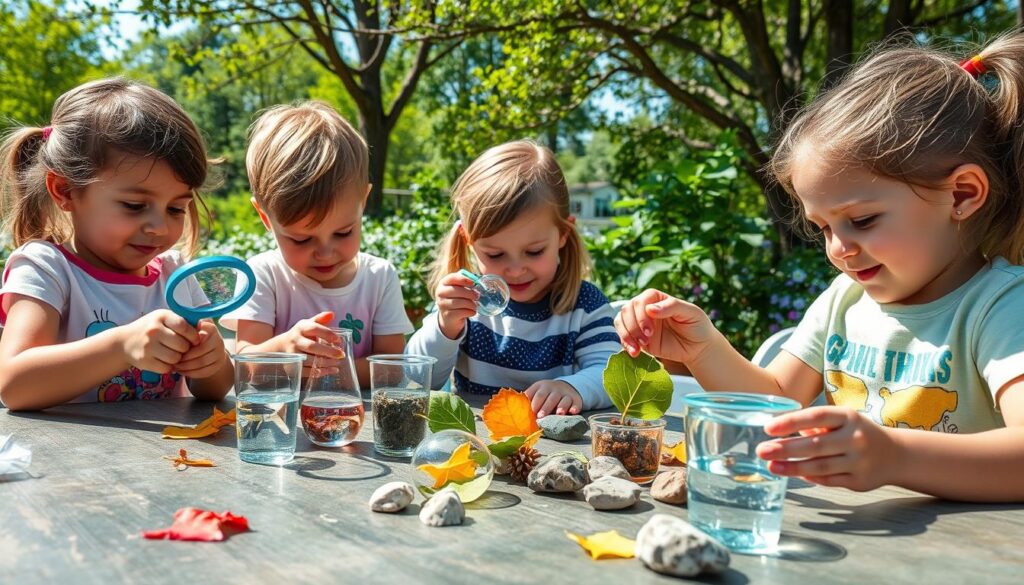
Outdoor Collection and Classification
Collecting and sorting items like leaves, rocks, or insects is a great activity. It encourages kids to explore and learn about nature. It’s a simple way to promote learning and discovery in preschoolers.
Technology and Digital Learning Components
Exploring hands-on stem for kids shows how technology boosts their learning. Fun stem activities meet digital tools for a fun learning mix. For example, apps like Khan Academy Kids and TinkerLab offer stem activities for tablets or smartphones.
Technology in stem education for preschoolers has many benefits. These include:
- Access to many educational resources and apps
- Interactive and immersive learning experiences
- Skills like problem-solving and critical thinking
When picking digital tools for stem learning, think about these:
- The child’s age and skill level
- If it matches learning goals and outcomes
- How easy it is to use and navigate

Adding technology and digital learning to hands-on stem for kids makes learning fun and complete. The right tools and resources make stem activities more enjoyable and effective. This sets the stage for future success in school.
Conclusion: Fostering a Lifelong Love of Learning Through STEM
Engaging young children in STEM education is rewarding and impactful. It lays the groundwork for a lifetime of curiosity and critical thinking. This foundation is key for academic success.
Hands-on experiments, building projects, and nature-based discoveries are essential. They help preschoolers develop vital skills. These skills will benefit them in school and their future careers.
It’s important to encourage a love of learning early on. This lets your little ones explore, question, and wonder about the world. It’s a way to help them grow and develop.
Early STEM exposure offers more than just academic benefits. It boosts confidence, problem-solving skills, and a growth mindset. These traits help children face challenges with enthusiasm and resilience.
So, start the STEM journey with your preschooler. Watch as their curiosity grows into a lifelong passion for learning. The possibilities are endless when you spark scientific exploration and engineering creativity in young minds.
